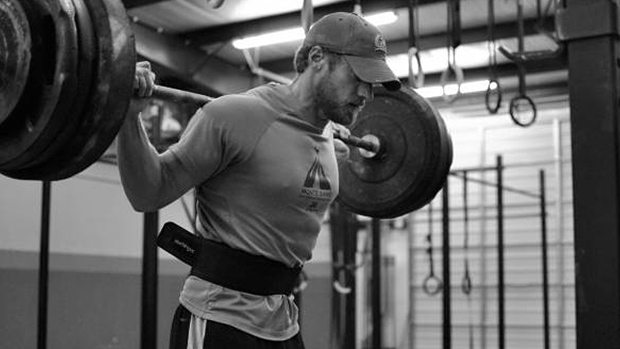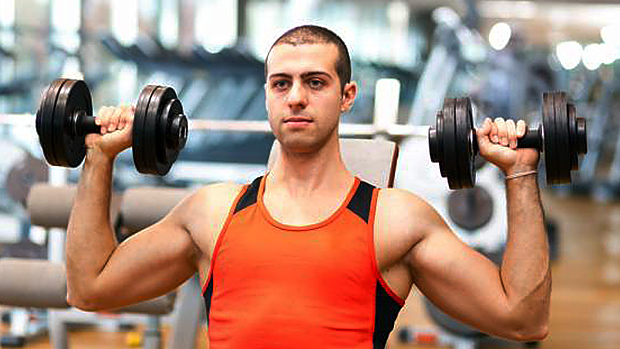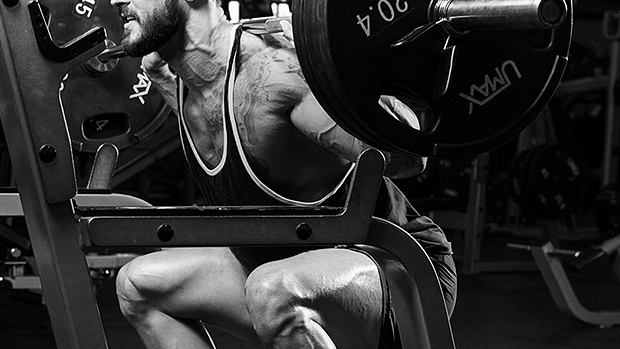Photo Credit: CrossFit Impulse, Alabama
Make the squat work for you, not against you. Squat frustration generally comes from not understanding your own biomechanics in relation to your leverages. Knowing what NOT to do is just as important as knowing what to do.
Your spine isn't straight, so "neutral spine" just means keeping it in its most natural position. Keeping a neutral spine that's secure and braced is important. In order to hold the natural position of the spine under a heavy load, there are a few things that must happen.
Master Intra-Abdominal Pressure
Stability in the lumbar spine is created by pushing outwards – not down – against the abs and obliques. You don't "crunch" down unless you're working the bro six-pack on the decline bench. Not during squats. Remember, the antagonist to the spinal erectors are the rectus abdominis. So when you contract them, you automatically invoke a degree of lumbar flexion – you get rounded. This is not ideal.
On the flip side, you don't want lumbar extension (hyperlordosis) either. This is something Instagram bikini competitors do in their glute pics – arch their lower back hard and stick their ass out as far as possible. Not that I'm complaining about it. But you don't want to be in this position and load your spine with hundreds of pounds.
To see how arching hard puts you in position of instability, try this: Arch your lower back very hard. Now push on your abs. They're soft, aren't they? And do your SI joints feel cranky? Having a "tight core" in regards to squatting and deadlifting is paramount. So why would you go into lumbar extension when the antagonist to the erectors are the abs? You want your abs to be soft during a squat? Cool. Makes sense. (No, it really doesn't at all. That was sarcasm.)
Whether you wear a belt or not doesn't matter. Stability through the lumbar spine is created through synergistically linking up musculature that helps the positioning of the spine in a coordinated manner, optimizing both directions and degrees of force. The only primary dynamic muscle in the "core" is the rectus abdominis, and it's the least important layer of the core musculature being discussed.
Problem is, people often get confused on how to brace properly with their midsection in order to create stability and maintain a neutral lumbar spine.
Here's a tip: Stand tall, get your chest high, and hold it there. Then make the same motion you make when you're constipated. You should feel your abdominal wall push out and the obliques press down. This creates the intra-abdominal pressure you need in order to maintain neutrality in the lumbar spine.
The other method is to learn how to the breathe into your diaphragm until it's maximally full of air. You'll see lifters take a big breath before they squat, but they end up doing so with their lungs. This does nothing to create intra-abdominal pressure or to help stabilize the lumbar spine.
Retract the Scaps. Retract the Lats.
Why? It helps keep the thoracic and lumbar spine neutral. But too many people struggle to get scapular retraction. Easy fix. Think about taking your shoulder blades and sticking them in your back pockets. There. You're welcome. Then flex your lats. Think about doing a chin-up or a lat pulldown and pull your elbows into your sides.
You also can't overlook the pecs with the lats and shoulder blade downward rotators, depressors, and retractors. In reality, both of these groups internally rotate the humerus and should be highly active in an isometric manner under the perfect shoulder and thoracic spine setup with the barbell squat. Creating depression at the shoulder blade is often overlooked, because the retractors get all the credit.
Stabilizing the shoulder girdle needs to involve the anterior structures as well. Ever heard that you have to use your pecs for optimal shoulder positioning under the bar? Probably not. But the pectoralis major involves internal rotation of the gleno-humeral joint and the pectoralis minor depresses the clavicle, which is a pivotal aspect of the shoulder complex, tapping into these two most overlooked aspects of positioning can improve squat form almost instantaneously.
Stop Flexing the Neck
Your neck can't be cranked backwards, nor can you be looking straight down. The ideal position is with the head pushed slightly back and the chin slightly tucked. Slightly. It's not excessive.
Know what's worse than herniating a disc in your lower back? Blowing up the tiny discs in your neck that you use literally to eat, speak, and live. It's a bitch. Remember all that stuff about hyperextension in the lumbar spine? Same can be said for the cervical spine. And these structures are far more acute and delicate. Protect your neck.

The misguided cue here is to "look up." You can look up with your eyeballs without cranking your neck backwards. Where you look isn't that important. Some guys look up, some look straight ahead, and some look down. What is important is to keep a neutral cervical spine regardless of where your eyes go.
This is taught as a means of "getting tight," but your hand placement has nothing to do with that. Elbow flexion has nothing to do with the scapula. You can have 90 degrees of shoulder flexion (meaning your arms are straight out in front of you) and generate as much tension in your mid-back as possible.
"But Paul, didn't you say above to think about doing a lat pulldown or chin-up to get your lats contracted?"
I did. But that has nothing to do with hand placement. That's addressing lat tension, which has more to do with your elbows and not your hand placement on the bar. This is about hands, not elbows.

You want to achieve and maintain maximum scapular retraction to create tension in the mid-back. Improper cueing is telling people to bring the hands in close in order to achieve this. Where your hands are on the bar isn't relevant to scapular retraction.
There's another issue with bringing your hands in as close as possible. For a great many people, this will lead to elbow pain down the road. When you bring your hands in as tight as possible, it creates elbow flexion. You put the brachialis into active tension throughout the entirety of the squat and also put the elbows into a position where the weight of the bar sends tension down directly into the joint. To avoid this, space your hands out wider and simply use your scapular retraction to create upper back tightness.
Last I checked, gravity was still in effect and no one had to worry about the bar floating off their shoulders. Coaches use this to get people to contract the lats, but you can do this without actually pulling down on the bar. Once scapular retraction is obtained, all you have to do is pull your elbows down and into your sides in order to get the lats to contract. A great cue here is to use a thumb-less, false grip. It tends to allow for better scapular downward rotation, depression, and retraction.
"But Paul, didn't you say hand placement doesn't matter?"
I did. Remember, your hands are not your elbows. Your elbows can be tight and in line with your torso with your lats isometrically contracted while your hands are very wide. Have you never heard of wide-grip lat pulldowns or wide-grip chins?
Generally, you want your elbows to run along the side of your body. One example of having this wrong is when someone "chicken wings" a squat, where their elbows shoot straight back. Another is where they get into the bottom position and their elbows are practically banging their knees. Neither of these are good because it means the lats aren't engaged and maximally contracted isometrically.
One of the first cues that gets taught in the squat is to hinge at the hips (sit back) in order to initiate the movement. But once you hinge at the hips, your knees should go into flexion and you should go straight down from there. I mean, that's what a squat is. You squat down. The problem you see is that people will sit back very far and continue excessive hip flexion throughout the descent.
The more you sit back, the more likely you are to get into hyperextension of the spine. Once you go into the concentric or lifting portion of the squat, the spine is then forced to get more rounded to compensate for the severe degree of bar travel, or create an even greater degree of hyperextension to try and keep the torso upright.
One reason lifters fall prey to the severe degree of hip flexion is because of the box squat technique. People who use box squats learn to descend the same way. The patterning creeps over into regular squats. But these are two totally different animals and should not be done the same way. The box squat is meant to load the hips and unload the quads. A properly performed barbell squat will never be performed in this manner, nor should it be.
So trying to mimic the box squat during a barbell squat is completely inappropriate. The further back your hips get, the more forward the bar is going to travel in relation to them. At this point the thoracic spine is put into a leverage disadvantage and will usually go into flexion because of the disadvantage it's put in (in relation to overcoming inertia). If you've ever seen a guy that gets very bent over in a squat, it's often because he keeps pushing his hips back through the eccentric portion of the squat, moving the path of the bar very far forward.
In order to maintain a neutral spine, you need an even break at the knees following your hinge at the hips. This keeps the path of the bar in line with the middle of the foot without losing spine neutrality. Have you ever felt yourself get forward on your toes in a squat? Then you lost correct bar path placement. Ever felt like you were going to fall backwards? Same issue.

Are you using the squat to maximize quad development? Glute development? Or are you just wanting to move more weight to increase your numbers? Knowing the answer should impact your training differently.
Here's the deal: Just because a muscle is active in a movement doesn't mean it's being asked to create significant tension in the movement. And if a movement doesn't cause a particular muscle group to have high amounts of tension involved in it, then the growth response in that area is going to be minimal.
Some say you need to do a deep squat to get the quads to grow and that the quads become more activated in a deep squat. Technically, this is true, especially for the vastus medialis (the tear drop muscle around the knee). But there's a difference in a muscle becoming activated in a movement and it having a great deal of tension on it.
Let's say you have a dimmer switch on your lights. If the lights are off, obviously they aren't active. If you turn the dimmer switch "on" but just barely move the knob, the lights are now "active," however they're very dim and give off very little light. If you turn the knob on all the way, the lights illuminate maximally.
When you do a full squat, the knee extensors do become more active. However, if the joint that's the furthest away from the applying force are the hips, then the knee extensors won't generate very much tension during the movement. Are they active? Yes. Are they creating a lot of tension? No.
So squat depth is irrelevant to quad development if the knee extensors aren't being asked to generate the greatest amount of tension in the movement. If the knees don't have a significant degree of flexion in the squat on the descent –they don't come very far forward – then the hip extensors will end up bearing the brunt of the work. And to come full circle, this happens when someone sits back too far in a squat.
You can squat well above parallel and the quads may have an enormous amount of tension on them because of a greater degree of knee flexion and extension. Or you can squat below parallel and they end up with very little tension because there's a greater degree of hip flexion and extension than at the knee. This isn't conjecture. It's physics. It's all relative to the distance between the applying force and the joint working against it.
So if your initial movement in the squat is to hinge at the hips, meaning you sit back, then how far you sit back is going to end up determining what area in the lower body ends up doing the most work. Depth becomes irrelevant at this point unless you're just squatting two inches down. Then you're not really working anything except your ego.
Mechanically, if you're trying to move as much weight as possible, then you want to play to your strengths, or divide the tension evenly between the hip and knee joints. If your goal is to move as much weight as possible and you're very quad dominant, then squatting with more knee flexion and extension is ideal. If you've got a big ass and strong adductors, then squatting with more hip flexion and extension is ideal. In either case, the path of the bar is still relevant and doesn't change. It should still be over the mid-foot position.
So what you do with your hips and knees will play a far bigger role in what creates the greatest amount of tension, muscular wise, when you squat. After that, depth plays a part in overall quad activation. But again, there's a difference in activation and maximal tension.
And lastly, depending on your goals and leverages, it's possible the squat may not even be a great movement for you. If you have long femurs and get very bent over in a squat regardless of what you do, then finding other movements to build your quads is probably going to be a much better solution. As good of a movement as the squat is, it has its shortcomings for some due to genetic leverage disadvantages. If you complete in powerlifting, then figuring out how to play to your strengths from a mechanical position will be vitally important.
1. Wearing knee wraps
If you're a competitive powerlifter, fine. I get it. But limit how much time you spend in them. If you're a bodybuilder, there's no reason to wear them.
Got knee pain without them? The muscles that stabilize the knee and provide for proper tracking and support are weak. And wearing wraps is a big part of why. Knee wraps are to the knees what high-top shoes are to ankles. High-tops inhibit proper ankle movement and flexion and the muscles that stabilize the ankle become weak. Thus, ankle sprains increase.
If you're a powerlifter that competes in wraps, throw them on 4-6 weeks out from a meet. Otherwise, leave them off. If you're a bodybuilder, throw them in the trash and address the weaknesses around the knee so that eventually your knee pain stops. Address the problem. Don't keep putting a Band-Aid on it.
2. Squatting higher because "squatting low" is bad for your knees
The greatest amount of shear force put on the knee joint actually occurs at above 90 degrees (above parallel) in the squat. So squatting higher than parallel is actually worse for your knees.
Dr. John Rusin contributed to this article.





